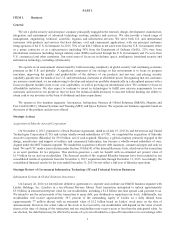Lockheed Martin 2015 Annual Report Download - page 20
Download and view the complete annual report
Please find page 20 of the 2015 Lockheed Martin annual report below. You can navigate through the pages in the report by either clicking on the pages listed below, or by using the keyword search tool below to find specific information within the annual report.of existing, follow-on or replacement programs. While we would expect to compete and be well positioned as the incumbent
on existing programs, we may not be successful or the replacement programs may be funded at lower levels.
Generally, we expect that the impact of budget reductions on our operating results will lag in certain of our businesses
with longer cycles such as our Aeronautics and Space Systems business segments and in our products businesses within our
Missiles and Fire Control (MFC) and Mission Systems and Training (MST) business segments due to our production contract
backlog. However, our businesses with smaller, short-term contracts are the most susceptible to the impacts of budget
reductions, such as our Information Systems & Global Solutions (IS&GS) business segment. We have also experienced
increased market pressures in these services businesses including lower in-theater support as troop levels are drawn down
and increased re-competition on existing contracts coupled with the fragmentation of large contracts into multiple smaller
contracts that are awarded primarily on the basis of price. Additionally, our services businesses across most of our business
segments have experienced lower volume due to improved product field performance that require less service support.
Changes in our business environment require us to be agile and evolve our business models, processes and products.
We are subject to a number of procurement laws and regulations. Our business and our reputation could be adversely
affected if we fail to comply with these laws.
We must comply with and are affected by laws and regulations relating to the award, administration and performance of
U.S. Government contracts. Government contract laws and regulations affect how we do business with our customers and
impose certain risks and costs on our business. A violation of specific laws and regulations, by us, a supplier or a venture
partner, could harm our reputation and result in the imposition of fines and penalties, the termination of our contracts,
suspension or debarment from bidding on or being awarded contracts, loss of our ability to export products or services and
civil or criminal investigations or proceedings.
In some instances, these laws and regulations impose terms or rights that are different from those typically found in
commercial transactions. For example, the U.S. Government may terminate any of our government contracts and
subcontracts either at its convenience or for default based on our performance. Upon termination for convenience of a fixed-
price type contract, we normally are entitled to receive the purchase price for delivered items, reimbursement for allowable
costs for work-in-process and an allowance for profit on the contract or adjustment for loss if completion of performance
would have resulted in a loss.
Upon termination for convenience of a cost-reimbursable contract, we normally are entitled to reimbursement of
allowable costs plus a portion of the fee. Allowable costs would include our cost to terminate agreements with our suppliers
and subcontractors. The amount of the fee recovered, if any, is related to the portion of the work accomplished prior to
termination and is determined by negotiation. We attempt to ensure that adequate funds are available by notifying the
customer when its estimated costs, including those associated with a possible termination for convenience, approach levels
specified as being allotted to its programs. As funds are typically appropriated on a fiscal-year basis and as the costs of a
termination for convenience may exceed the costs of continuing a program in a given fiscal year, occasionally programs do
not have sufficient funds appropriated to cover the termination costs were the government to terminate them for convenience.
Under such circumstances, the U.S. Government could assert that it is not required to appropriate additional funding.
A termination arising out of our default may expose us to liability and have a material adverse effect on our ability to
compete for future contracts and orders. In addition, on those contracts for which we are teamed with others and are not the
prime contractor, the U.S. Government could terminate a prime contract under which we are a subcontractor,
notwithstanding the quality of our services as a subcontractor. In the case of termination for default, the U.S. Government
could make claims to reduce the contract value or recover its procurement costs and could assess other special penalties.
However, under such circumstances we have rights and remedial actions under laws and the Federal Acquisition Regulation
(FAR).
In addition, certain of our U.S. Government contracts span one or more base years and multiple option years. The U.S.
Government generally has the right not to exercise option periods and may not exercise an option period for various reasons.
However, the U.S. Government may exercise option periods, even for contracts for which it is expected that our costs may
exceed the contract price or ceiling.
U.S. Government agencies, including the Defense Contract Audit Agency, the Defense Contract Management Agency
and various agency Inspectors General, routinely audit and investigate government contractors. These agencies review a
contractor’s performance under its contracts, its cost structure, its business systems and compliance with applicable laws,
regulations and standards. Any costs found to be misclassified may be subject to repayment. We have unaudited and/or
12
























